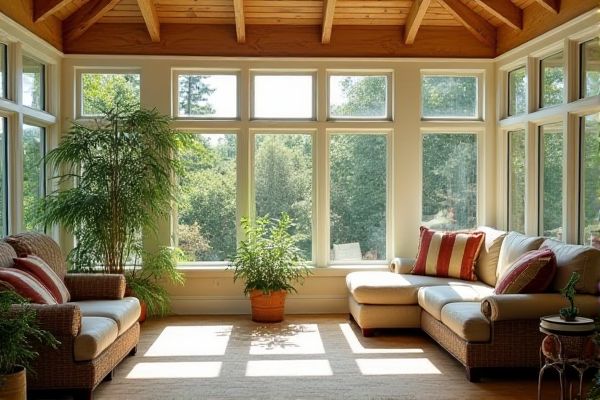
Sunroom windows are designed to maximize natural light and offer superior insulation, creating a comfortable indoor environment year-round, while regular windows provide standard ventilation and light control without specialized thermal properties. Discover how choosing the right window can enhance Your living space by exploring the full comparison in the article ahead.
Table of Comparison
| Feature | Sunroom Windows | Regular Windows |
|---|---|---|
| Purpose | Maximize natural light and outdoor views in sunrooms | General ventilation and light for standard rooms |
| Glass Type | Often tempered, insulated, or UV-protected glass | Standard single or double-pane glass |
| Frame Material | Aluminum, vinyl, or composite for durability | Wood, vinyl, aluminum, or fiberglass options |
| Energy Efficiency | High-performance glazing to reduce heat loss and gain | Varies; standard options less optimized for sunroom use |
| Size & Configuration | Larger, fixed or operable panels for panoramic views | Various sizes, mostly operable for airflow |
| Installation Location | Specifically designed for sunroom enclosures and additions | Installed in walls of standard living spaces |
| Cost | Generally higher due to specialized materials and design | More affordable and widely available |
Understanding Sunroom Windows: An Overview
Sunroom windows are designed with larger glass panels and enhanced insulation properties to maximize natural light and thermal efficiency compared to regular windows. Typically constructed from durable materials like vinyl or aluminum, they offer superior resistance to weather elements while providing panoramic views. These windows often feature specialized glazing options that improve energy conservation and reduce UV exposure, making them ideal for sunroom environments.
What Defines Regular Windows?
Regular windows typically consist of standard framed glass panels designed for ventilation, natural light, and basic weather protection in conventional home settings. Unlike sunroom windows, they often lack enhanced thermal insulation or expansive glass surfaces aimed at maximizing sunlight exposure. Understanding the distinction helps You choose the optimal window type based on energy efficiency and aesthetic preferences for different living spaces.
Purpose and Functionality: Sunroom vs Regular Windows
Sunroom windows are specifically designed to maximize natural light and provide expansive outdoor views while offering insulation and weather resistance, making them ideal for sunroom environments. Regular windows primarily serve ventilation and basic lighting needs, with a focus on security and standard energy efficiency. The enhanced glazing and larger dimensions of sunroom windows create a bright, comfortable interior space distinct from the typical functionality of conventional windows.
Material Differences Between Sunroom and Regular Windows
Sunroom windows typically feature tempered or laminated glass designed for enhanced insulation and UV protection, unlike regular windows that often use standard glass. Frames in sunroom windows are usually constructed from durable materials such as aluminum or vinyl with thermal breaks to withstand extreme weather conditions. The combination of specialized glass and robust framing materials ensures superior energy efficiency and durability in sunroom installations compared to typical residential window designs.
Energy Efficiency: Comparing Both Window Types
Sunroom windows typically feature specialized glazing and insulated frames designed to maximize energy efficiency by reducing heat transfer, keeping interiors warmer in winter and cooler in summer. Regular windows often lack the advanced thermal performance found in sunroom windows, leading to higher energy loss and increased utility bills. Choosing energy-efficient sunroom windows can significantly enhance temperature regulation and lower overall energy consumption compared to standard window options.
Cost Considerations and Budgeting
Sunroom windows generally cost more than regular windows due to their larger size, specialized materials, and enhanced insulation properties that improve energy efficiency. When budgeting for your sunroom, consider installation expenses and potential long-term savings from reduced heating and cooling costs. Choosing high-quality, energy-efficient sunroom windows can be a smart investment that balances upfront costs with durability and comfort.
Customization and Design Flexibility
Sunroom windows offer exceptional customization and design flexibility compared to regular windows, allowing you to choose from a variety of shapes, sizes, and glazing options to maximize natural light and enhance aesthetic appeal. These windows often feature thermally efficient frames and customizable shading solutions tailored to your sunroom's unique architectural style. By prioritizing design adaptability, sunroom windows create a seamless indoor-outdoor experience while optimizing energy efficiency and visual comfort.
Maintenance Requirements for Sunroom vs Regular Windows
Sunroom windows typically require more frequent maintenance due to increased exposure to sunlight, temperature fluctuations, and moisture, often necessitating regular sealing and cleaning to prevent warping and mold growth. Regular windows generally have lower maintenance needs, with standard cleaning and occasional inspection for drafts or damage being sufficient. Materials like vinyl or aluminum used in sunroom windows can improve durability and reduce long-term upkeep compared to traditional wood-framed regular windows.
Durability and Lifespan Comparison
Sunroom windows are typically designed with enhanced durability, using thicker glass and reinforced frames to withstand harsher weather conditions compared to regular windows. The lifespan of sunroom windows often exceeds 20 years with proper maintenance, while regular windows may need replacement every 15 to 20 years depending on material and exposure. When choosing your windows, consider the durability and longevity requirements of your space to ensure optimal performance.
Choosing the Right Window for Your Home Addition
Sunroom windows are specifically designed to maximize natural light while providing superior insulation and UV protection, making them ideal for home additions that aim to create a bright, energy-efficient space. Regular windows typically offer standard ventilation and insulation but may lack the thermal performance and expansive views that sunroom windows provide. Your decision should balance aesthetic goals, energy efficiency, and climate considerations to enhance comfort and value in the new living area.
 homyna.com
homyna.com